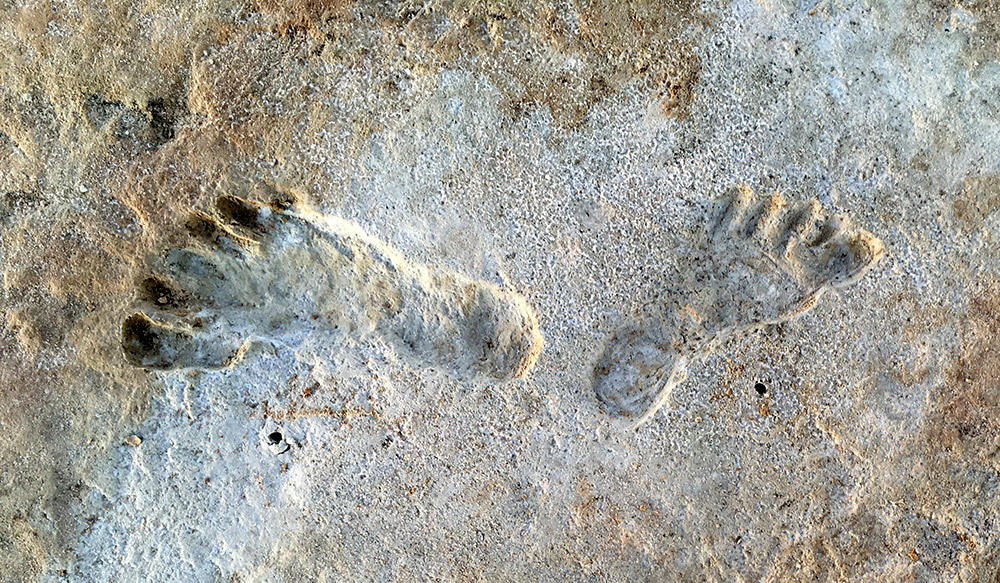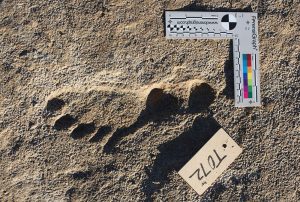
The Americas: A Pre-Ice Age Settlement? – New dating confirms: Fossilized footprints in New Mexico are older than current theory suggests
October 6, 2023, Reading Time: 4 minutes.
The mystery deepens: the first people to settle in the Americas were earlier than thought – they were already in the southern United States during the cold phase of the Ice Age 22,000 years ago. This has been confirmed by two new dates for fossilized human tracks discovered in New Mexico in 2021, dispelling earlier doubts about their original dating. However, it is not yet clear how these first people arrived in this region from Asia, despite the ice sheet extending far to the south.
It is not yet clear when the first people settled in the Americas. It has long been thought that this could only have happened about 13,000 years ago, when North America’s Ice Age glaciers opened a path south. But in recent years, more archaeological discoveries have cast doubt on this. 30,000-year-old stone tools from Mexico, a 36,000-year-old mammoth slaughter site in the southern United States, and 25,000-year-old necklace pendants from Brazil suggest that the New World must have been inhabited before or before the height. of the last ice age.
Are prehistoric footprints the right age?
Human footprints found in New Mexico’s White Sands National Park in 2021 are still evident. “Unlike cultural artefacts, altered bones or other fossils, footprints have a clear context and are firmly embedded in the associated layer,” explains the team led by Matthew Bennett from Bournemouth University. Radiocarbon dating of plant remains in the footprints suggests the footprints are 21,000 to 23,000 years old — and therefore formed at the height of the last Ice Age.
The findings and their dating sparked controversy: “The immediate reaction in some archaeological circles was that our dating was not reliable enough to make such a far-reaching decision,” explains Jeff Picati of the US Geological Survey. Criticism was primarily fueled by the team’s use of fossilized seeds of an aquatic plant for their radiocarbon dating. However, because aquatic plants absorb carbon from the air, dating based on carbon isotope ratios is distorted.
Re-dating using two methods
Now Bennett, lead author Picati and their colleagues have provided additional evidence of the antiquity of the white sand footprints. To do this, they took samples containing a total of 75,000 conifer pollens, which were preserved in layers of prints, and subjected them to radiocarbon dating. As conifers, as terrestrial plants, obtain carbon from the air, the general mixing of aquatic plants is excluded.
In addition, the researchers used optically stimulated luminescence (OSL) as a second, independent dating method. Radiation from excited quartz grains reveals when they were last exposed to daylight. For this dating, Picati and his team used three different sediment samples from the layer directly below the prehistoric footprints.

Human presence already in the Ice Age
Conclusion: Both radiocarbon dating of conifer pollen and OSL dating confirmed the previously determined age of the footprints. Accordingly, they are actually 21,000 to 23,000 years old. The type of plant pollen the team found at the site also fits the picture: “The pollen came from plants that were typically found in cold and wet Ice Age climates,” reports Picati’s colleague David Wall. Today, however, it is primarily heat-loving desert plants that grow in this part of the southern United States.
“We were already confident that our dating was correct because of the strong geological, hydrological and stratigraphic evidence,” says Kathleen Springer, associate first author of the USGS. “But we know that independent regulation is important.” Now a new study shows that the first established chronology for the White Sand footprints is robust. “Our new dating confirms that people were present in North America during the last glacial maximum,” the scientists say.
When and how did the first humans arrive in the New World?
Bente Philippsen of the Norwegian National Laboratory for Age Determination in Trondheim sees it similarly: “It is highly unlikely that all sources of error in age determination produce the same error,” writes a researcher not involved in the study. A companion commentary on “Science.”
Footprints from the White Sands provide further evidence that the first migrations from Asia to the Americas must have occurred before or during the last ice age. However, it is not clear how they accomplished this, which route they took and how they survived despite the adverse conditions. (Science, 2023; doi: 10.1126/science.adh5007)
Quelle: Science, US Geological Survey
October 6, 2023 – Nadja Podbregar

“Coffee fanatic. Friendly zombie aficionado. Devoted pop culture practitioner. Evil travel advocate. Typical organizer.”
